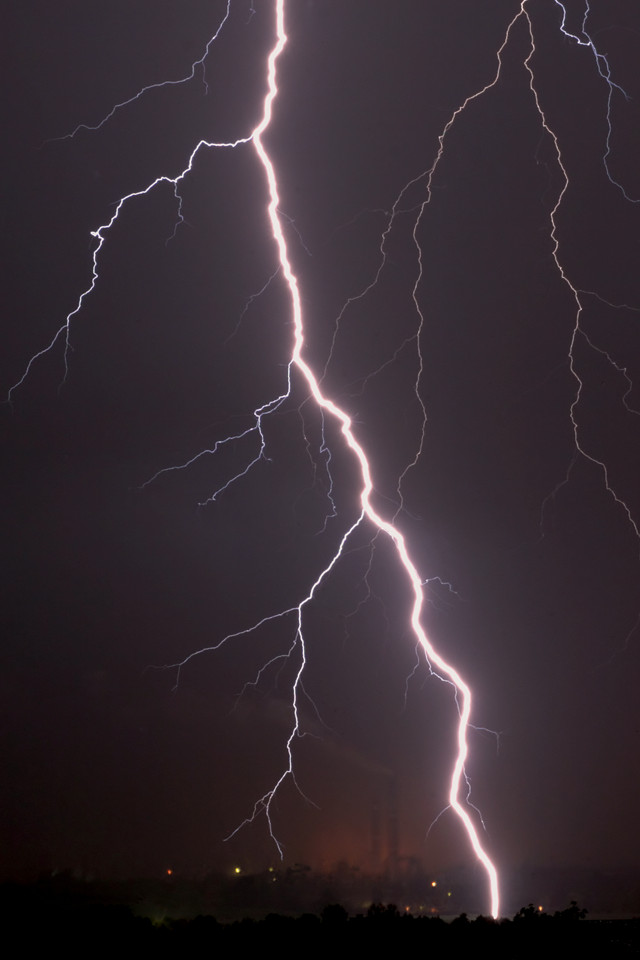
by David B. Williams Monday, April 20, 2015

The continental U.S. will see more lightning in the future as storm energy and precipitation rates rise with global warming, according to new research. Credit: ©Lyoha123, CC BY-SA 3.0.
Add more lightning to the list of predicted effects of climate change. A recent study in Science forecasts a significant increase in the number of lightning strikes within the continental United States over the next century.
In the study, researchers led by David Romps, an atmospheric scientist at the University of California at Berkeley, considered a straightforward phenomenon: that increased convective instability, or storm energy, and precipitation rates translate to more lightning. Both factors are predicted by global climate models to increase in coming years, with a pronounced increase in instability foreseen for the U.S.
To generate lightning, a storm needs strong, rapidly rising updrafts and suspended water, either as a liquid or solid. Collisions between water particles of different charge and size, such as between small ice crystals and millimeter-scale pellets called graupel, enable the exchange of electric charges. So, the stronger the updrafts and the more water in suspension, the more electrical exchange and more lightning. On average, there are about 22 million cloud-to-ground lightning flashes annually in the lower 48 states and coastal waters. Worldwide, lightning hits the ground about 100 times per second.
Previous research has suggested increases in strikes due to climate change based on modeling, as well as on observations, the researchers noted, but predictions from these earlier efforts have varied considerably. Romps and his colleagues proposed that a more robust prediction of lightning flash rates should scale with the multiplied product of the precipitation rate and the local convective available potential energy (CAPE), a measure of how much energy is available to storms.
To test their hypothesis, the scientists compared three overlapping data sets for the contiguous United States in 2011: CAPE measurements collected by radiosonde-equipped weather balloons and archived by the SPARC (or Stratosphere-troposphere Processes And their Role in Climate) project; precipitation rates collected by the National Weather Service (NWS) River Forecast Centers; and lightning flash data collected by the National Lightning Detection Network. The researchers found that the mathematical relationship combining the two storm properties accounted for 77 percent of the variance in lightning strike data across the country.
It “seemed too good to be true,” Romps says, adding that the results “gave us the confidence to predict lightning in the future.”
Using meteorological data from 11 different global climate models, he and his colleagues calculated a 12-percent rise in lightning strikes within the continental U.S. per degree Celsius of warming. A 4-degree-Celsius increase would thus lead to a 50-percent increase in the lightning strike rate by the end of the century, they reported.
Not everyone within the atmospheric science community is convinced yet by the new method, however. “CAPE has been useful in determining certain aspects of severe storms, but it may not be sufficient for determining lightning specifically,” says Donald Wuebbles, an atmospheric scientist at the University of Illinois at Urbana-Champaign. “There has not been a good analysis of this application” yet, he says.
Lightning causes roughly half of all wildfires in the U.S., Romps notes, as well as 51 fatalities per year on average, according to the NWS. Considering that climate studies already predict an increase in wildfires because of warmer temperatures and earlier snow melt, the added possibility of more lightning strikes with warming could multiply the risk for humans in the future.
© 2008-2021. All rights reserved. Any copying, redistribution or retransmission of any of the contents of this service without the expressed written permission of the American Geosciences Institute is expressly prohibited. Click here for all copyright requests.